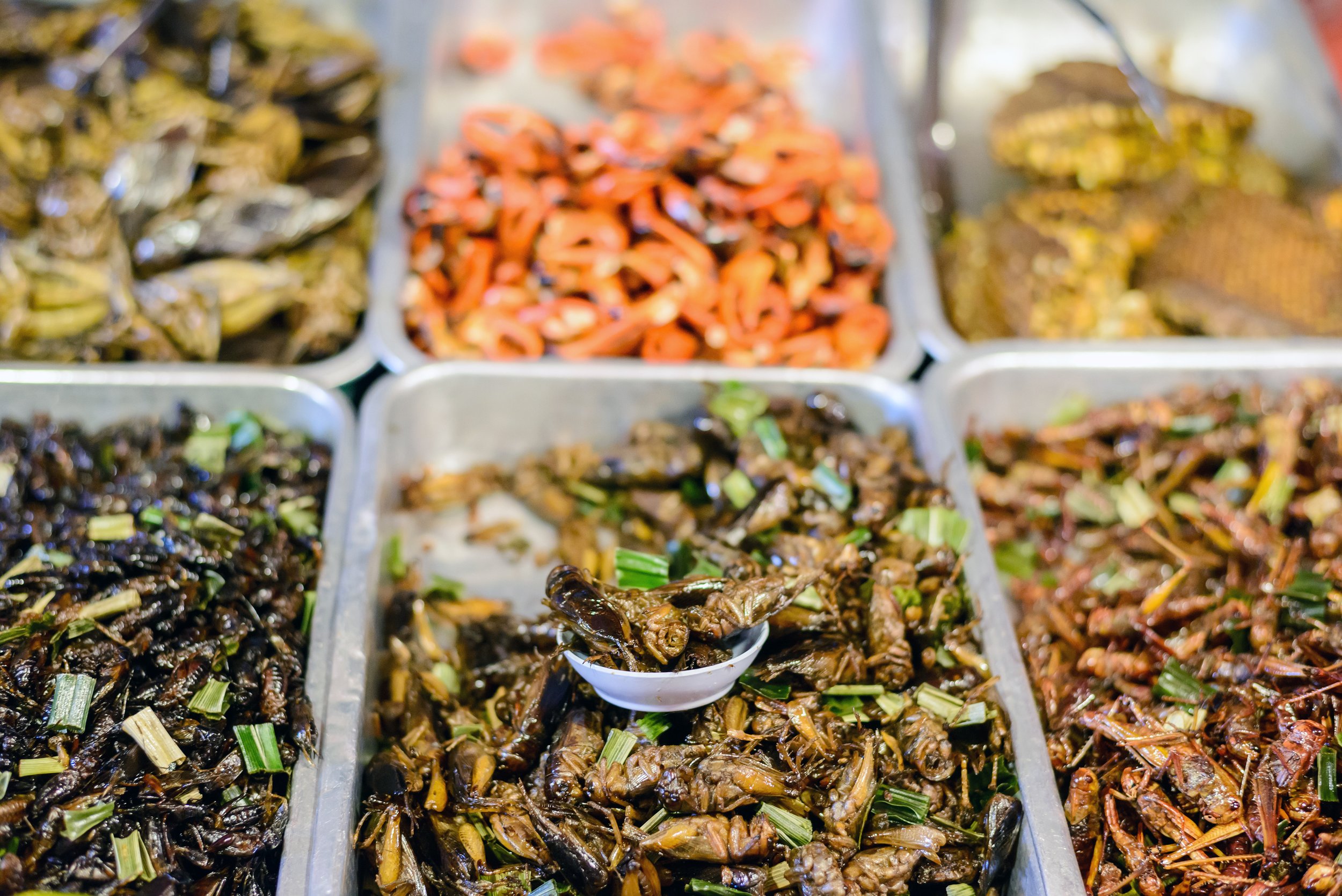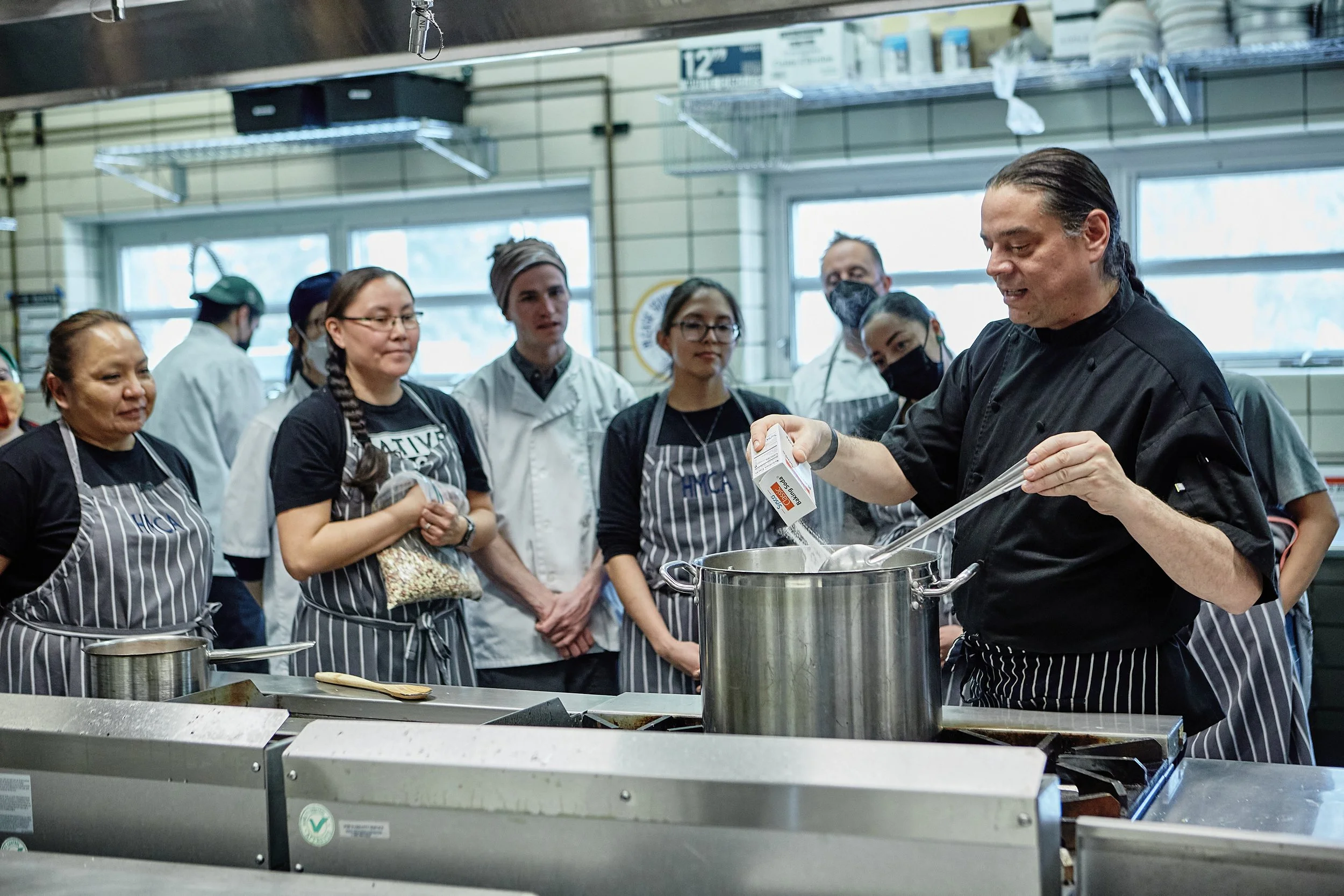
Beyond the Bug Buffet
By Taylor Brandt and Christopher Dyrland-Marquis
Indigenous Practices for Sustainable Protein
Exploring Indigineous delicacies with Chef Sean Sherman
“You are on Native Land.” The words billowed across an enormous screen in Montana State University’s Inspiration Hall: 55 feet of text undulating in front of a chattering, boisterous audience. As spectators continued to stream into the crowded auditorium, it became increasingly apparent that the keynote speaker, Sean Sherman, had garnered something of a celebrity status at the university’s 34th Annual Bug Buffet. His ongoing mission to promote and develop underrecognized, Indigenous food systems attracted scores of attentive listeners. After an impassioned introduction led by MSU’s Danielle Antelope—a sustainable food and bioenergy student from Browning, Montana—Sherman took the stage.
Photo by Olivia Chamberlin
Born in Pine Ridge, South Dakota, Sherman—Oglala Lakota—has dabbled in cuisines for over 30 years, with the majority of his career revolving around native, local sources. “A few years into my chef career I realized that I knew very little about my own heritage,” Sherman noted. “I made the decision to start to try and understand what my Lakota ancestors were eating.” While the search for local nutrition extends into food avenues that some might reflexively shy away from, Sherman encourages a more open-minded view: “People shouldn't be afraid of animals if it doesn't happen to be a cow or a pig or a chicken. They’re not even from these landscapes … At our restaurant we have crickets on the menu, and we go through about 15 pounds of crickets a week—and crickets don’t weigh that much, so that's a lot of crickets.”
Sherman's journey to understand Indigenous food systems began in 2014. His focus on the revitalization and evolution of Indigenous food systems throughout North America has led him to many successes, including the establishment of an Indigenous food education and catering business—The Sioux Chef—and authorship of an Indigenous cookbook. In July 2021, he directed his passion into launching the nonprofit, North American Traditional Indigenous Food Systems, and also unveiled Minneapolis’ first full-service, Indigenous restaurant: Owamni.
Through his journey to learn about Indigenous food systems, Sherman discovered that they are inseparable from history. He highlighted how western colonization has systematically eliminated native cuisines and peoples. “The United States has never come to terms with its own history of how it became a world power by stealing Indigenous lands,” Sherman said. “We have to remember how young the United States actually is. If you look at a map of the year 1800 … the Western Frontier is Ohio.”
“At our restaurant we have crickets on the menu, and we go through about 15 pounds of crickets a week—and crickets don’t weigh that much, so that’s a lot of crickets.”
In the United States, many notable historical figures had a role in this destruction. Sherman points to George Washington, providing evidence that the first President ordered the complete destruction of intricate, Indigenous farming systems in 1779. “We have to remember how damaging that one century is for Indigenous peoples,” Sherman said. He lamented how land-loss, relocations, enslavement, and genocide all stem from western colonization. “We see not only a huge loss of Indigenous food access, but [how] our whole world changed because of the colonial machine coming in, putting settlers everywhere, stripping this land of all sorts of natural resources to make a [sic] very few people very rich.”
Though acknowledging a history of immoral mistakes can unearth wounds many wish to ignore, Sherman argues that progress depends on earnest reflection and the conscious choice to honor diets from the landscapes around us. He also asserts that improving Indigenous food access helps promote deeper connections. “To understand Indigenous foods is to understand diversity,” Sherman states. “You have to just think about all these wonderful regions and all the different plants and animals that live here.”
Photo by Olivia Chamberlin
If today’s citizens wish to build deeper connections with the land they inhabit, the largest obstacle to overcome might be our current mindsets on food systems. Current agricultural practices alter the land to better fit crops or livestock—we disrupt wildlife movement with fenced-in land and spray imported crops with our newest “pest”-icides. Sherman ultimately wishes to see the opposite. He argues, “Making food taste like where you are, white cedar, and wild rice, and rabbit, and cranberries—I can stand in that spot in Minnesota and see all these ingredients just right around me—that's how we should be thinking about food and flavor.”
As his presentation wrapped up, a brief Q&A session passed a microphone between curious listeners. One gentleman inquired how people of colonial descent might act as an ally to Indigenous food systems. “A lot of it is purely supporting and realizing that there's so much work to do,” Sherman responded. “We should be very choosy as to who we're supporting and who we're purchasing from.” Another woman who had been perched on the edge of her seat asked how Montana’s ranching industry might better accommodate Indigenous agriculture. Sherman responded by highlighting the significant impacts of western colonization: “Land access is a huge issue. If you look at the statistics, 98% of all land ownership is still in the hands of white Europeans,” he reported. “If you look at the history of how the land changed through really intense logging, mining, and cattle ranching, it really was an environmental disaster across the board. There's definitely healthier ways to run cattle, but we should also just be thinking about allowing some of these lands to really grow… to reach the full potential of what they can be.”
Photo by Adrian Sanchez-Gonzalez
Such a powerful conclusion to the Bug Buffet’s keynote lecture left many attendees lingering to discuss how they might further involve themselves with Indigenous food avenues. In the stands, introductory speaker Danielle Antelope sparked an enthusiastic discussion about current efforts to bring bison back onto Montana lands. Departing from Norm Asbjornson’s Inspiration Hall, the forum’s cacophony gradually ebbed and faded as the audience continued brainstorming in the growing twilight.
While its keynote presentation provoked important questions about the ethics of our existing food systems, the 34th Annual Bug Buffet was far from finished. The week-long affair hosted an entire roster of events and activities to explore: ranging from histories of edible insects across western North America, to their importance in Indigenous cuisines. Earlier that day, the buffet kicked off in the Strand Union Building, where University Catering Services provided opportunities for community members to experience insect cuisine first-hand. This year's menu featured edible insects used historically in the West’s Great Basin by Native Americans: pumpkin bread baked with crickets and mealworms, chili simmered with scorpions, spicy black ant tamales, and a surprisingly varied selection of food made with chapuline grasshoppers—salsas, wild rice with juniper-berry sauce, and sunflower seed pemmican. There were even Native American cookies baked with love, crickets, and grasshopper powder!
“Rich in both beneficial fats and protein, insects are also quite high in calcium, iron, and zinc.”
Surrounding each table, posters and flyers explained the benefits of eating insects. Each noted that although consuming them may seem off-putting at first, there are many beneficial reasons to add bugs to your diet. Rich in both beneficial fats and protein, insects are also quite high in calcium, iron, and zinc. Additionally, they promote environmental benefits: when compared to livestock, insect nutrients result in lower carbon emissions, and require less land and water to harvest.
With Sherman’s passion for Indigenous food systems setting the tone for Montana State University’s Bug Buffet, many students capitalized on an opportunity to expand their worldviews. Clare Menzel, a history graduate student, stated that she enjoyed the idea of Indigenous food—specifically, eating insect cuisine. She remarked, “I like the little bugs … I specifically would choose something [to eat] with more visible bugs.” Some students even developed preferences: “I'd have to say the ant tamales have been my favorite [insect dish] because tamales remind me of my original home of Dallas, Texas,” Noah Johnson, a music technology student, explained. “I grew up eating so many tamales, and the ants are tasteless, so I could probably eat that all day.” Others were less comfortable with the idea of insect protein and firmly disagreed. “Seeing the bugs, I think, makes it worse,” hedged Isaac Winemiller, a music technology student. “But, if you told me it was something else, I honestly wouldn't be able to tell that it's bugs.”
The popularity behind Montana State University’s Bug Buffet has certainly come a long way. The first event was held in 1989 and only consisted of a pound of butter, a frying pan, and some grasshoppers! Since its humble origins, however, this curious event hasn’t stopped gaining traction. In August 2020, MSU became the first university in the U.S. Land Grant System to put bugs on a daily catering menu as part of its goal to use ingredients with minimal carbon footprints. With no signs of stopping anytime soon, any would-be bug patrons can look forward to next year, where future events will continue to celebrate sustainable food avenues—and continue to terrify the squeamish.



